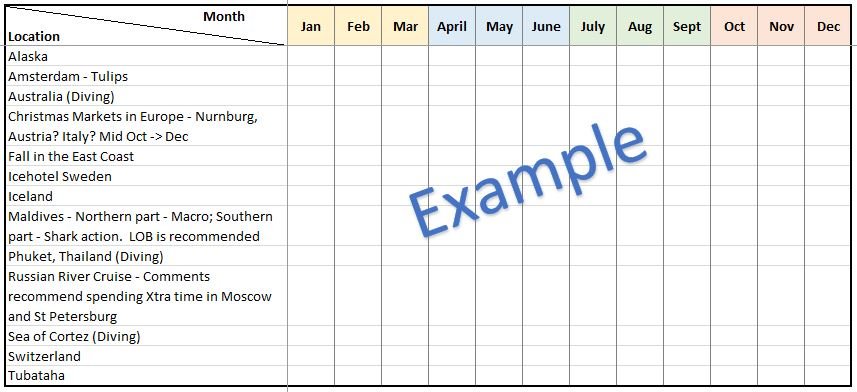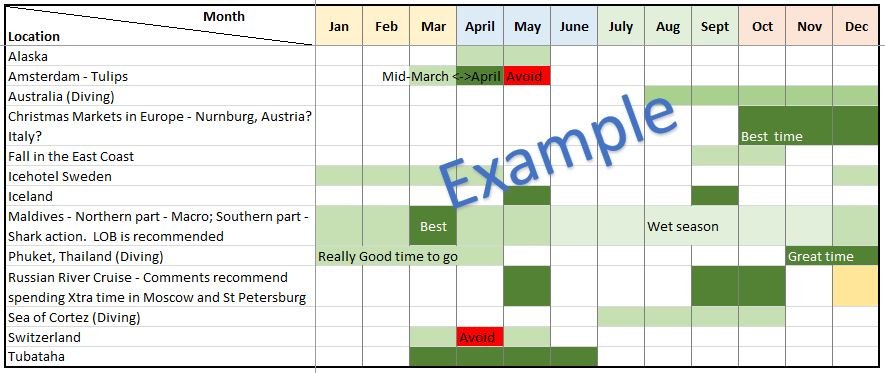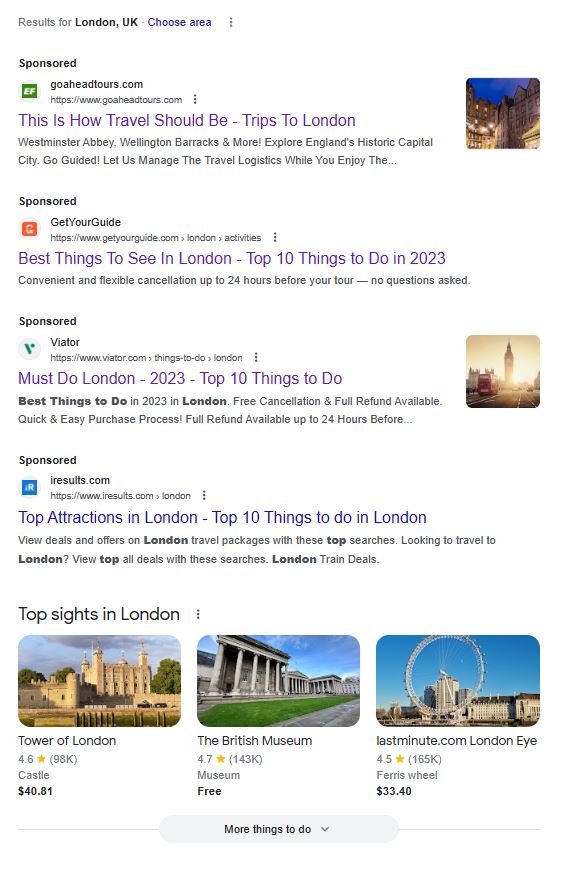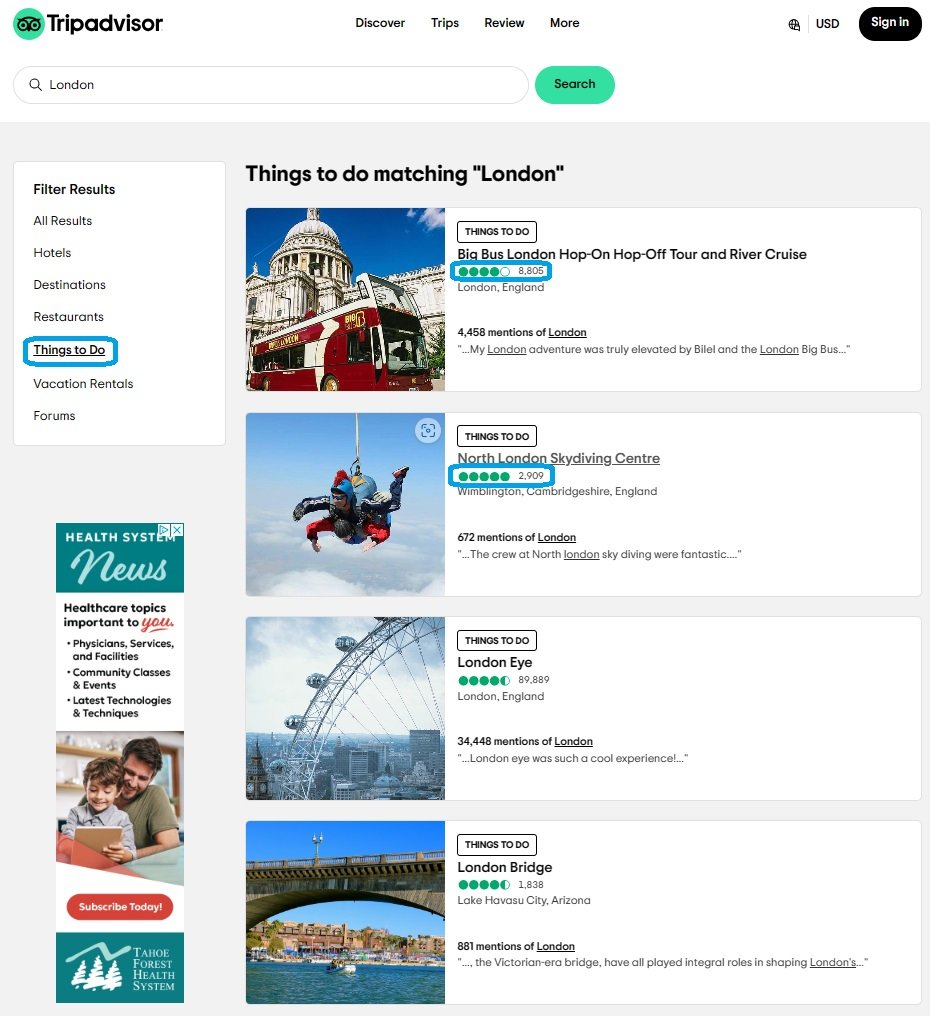One question I am asked frequently is, “How do I decide where to go next?”. Given so many places to visit, it can be daunting to figure out where to begin. You are the best person to know where you want to travel, when you want to travel, and how to make it uniquely your trip.
Deciding where to go on my next vacation requires a little prep work. After following the 3 simple steps below, you will determine where your next vacation location will be.
- Brainstorm places you would love to see.
- Research when is the best time to go.
- Explore what there is to do.
Brainstorm
What does brainstorming mean?
“A group discussion to produce ideas or solve problems.” – Source: Oxford Dictionary
When I started my brainstorming exercise, I created a table where I could jot down places I dreamed of going. Here is the Excel table I started with:

Things to remember:
- There is no right or wrong answer.
- There is no limit as to how many places you can list.
- The intent is to just start capturing your “I would love to go to ….” places so you can refer to it when you get the travel “itch”.
How did I go about populating my list? First, my husband and I just started jotting down places we talked about over the years. Next, after we exhausted our thoughts, I talked to family and friends about their vacations and captured the ones I thought were fascinating. Lastly, If I saw photo of an amazing waterfall, mountain, or ocean, I would find out where it was and write it down.

This is how my original list appeared – it looks different today because I am always updating it with new places to go. Notice there are no notes or comments in the months, yet. That information is included after researching when is the best time is to go.
Research When to Go
You have your starting list of locations; how do you determine the best time to travel there? This is where an online search engine (Google, Bing, etc.) is your friend. Do a search for “best time to visit _____”, and see what information comes up. When doing your research, make note of what months should be avoided, as well.
For example, Amsterdam is on my list (based on a recommendation from a friend). When I type “best time to visit Amsterdam“, Google came up with the following result:
“The best time to visit Amsterdam is typically from late April to early May, when the weather is mild and the tulips are in bloom. However, the city is busy with tourists during this time, so be prepared for crowds. If you’re looking for a quieter trip, consider visiting Amsterdam in late September or October.”
As I am doing my research, I am updating my table for the best (and worst) months to visit. My notes and colors look like this:

Using the above search example (and that I want to see the tulips), I shaded April green and May red. Why? I like to avoid crowds, and May is busier than April. March is also shaded a “lighter green” because there are tulips in March, just not as many of them.
Based on the information I find, I shade months either green, yellow, or red to easily see which months are more favorable than others. I do not have a formal definition of what each of the colors mean other than dark green is “GREAT” and red is “AVOID”. Some things to think about when color-coding your table:
- Are there only certain times when things happen -seeing the fall foliage on the US East Coast is not going to occur in June. So only note the months when may occur.
- Do you want to avoid cold? Going to Australia and New Zealand in June-August are some of the coldest months, so you may want to shade those as red.
- What months are rainy? Do you mind if it rains? What about monsoon or hurricane season?
Each place is different and there might be different reasons why a time is better or worse. Use colors and annotation based on what resonates with you.
Explore What to do
You have your list and now it is time to travel – WOOHOO!! What month(s) are you considering and which places are best during that time? You should (hopefully) have a few options shaded green (the darker the better) to choose from. Hopefully your list is longer than you have time for (an excuse for another vacation), then how do you choose where to go?
This is the part I enjoy the most about planning a trip. Researching various locations while learning some of the history, unique culture, and activities I never knew before. In starting my research, I use a multi-pronged approach – I leverage my Friends, Search Engines, and Pre-Defined Tours.
Friends
Starting with Friends – do you know someone who has traveled to where you are interested in going?
- What did they do?
- What did they see?
- When did they go?
- How long were they there?
- What would they skip?
- Would they go back?
- What would they have done differently?
The last 2 questions are where you will unearth some nuggets on what to avoid or how to plan your trip better.
Search Engines
Google (or Bing, or….) search engine – I search on “Best things to see in ……”, and then go through the results. You can tailor your search to focus on your interests – sports, national parks, SCUBA Diving, history, food, etc. For example, if I type in “Best things to see in London“, below is one of the results:

By looking through the above results. you can see what other people and companies are doing. Look for patterns where something is recommended more than once – these are normally the highlights of the area.
Pre-Defined Tours
Now for pre-defined tours – “What?!?! I thought you didn’t like tours!” In this situation, exploring pre-defined tours can be helpful. Why? When looking at multiple tour sites, I am looking for the following information:
- How much do they cost? Every once in a while a tour is cheaper than going solo. This normally happens if the tour company is able to obtain a group discount.
- Where do the tours go? What do they see? How much time does the tour company spend there? Do multiple tour companies go to the same place? This will help your narrow down what is the “don’t miss” sites and a minimum amount of time to see it.
- Does the tour company enable priority access to places that have long lines. is hard to book or is remote and hard to get to, etc.? For example, continuing with the London research, Bletchley Park is not easily accessible without a car and a day tour might be an option.
Where can you find tour options? My primary source is Trip Advisor. There, I can search for “London” and if I select “Things to Do“, it shows me a varietal list of activities that can be done in and around London. I also like that it includes reviews and ratings from people that have chosen those tours so I have some idea as to how good they might be or what the experience is.

Once you have captured what to see during the month(s) you are looking to travel, take a step back and look at each place. Does one location look more appealing/interesting over another If so, then you have identified the next place you want to travel to!
Summary
Preparing a list of locations that includes the best time to visit will make deciding and planning your next trip easier. Maintain it as you hear of new places to go. I discovered most of my updates occur while I am on vacation! I meet new people, listen to their travels, and then add the new locations to my spreadsheet.
Enjoy learning the history, adventures, and activities that await you when you finally arrive at your destination. Safe travels!